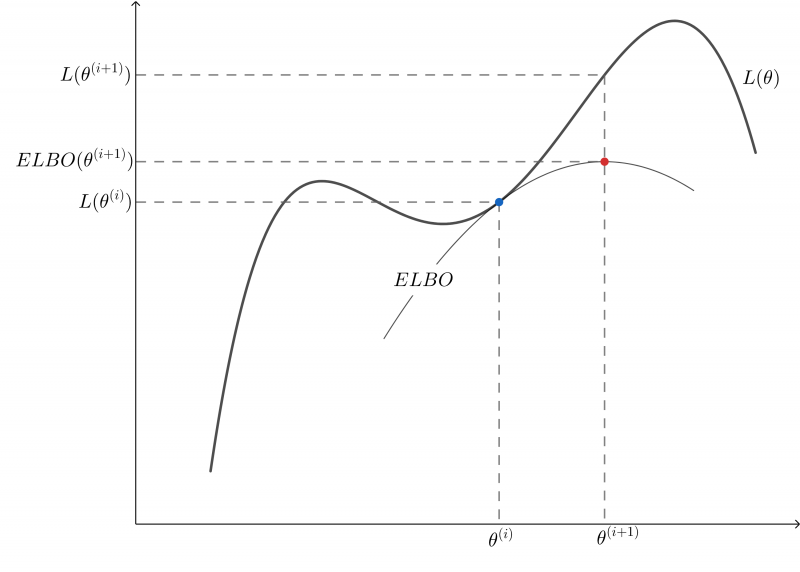EM算法
EM算法是用于含隐变量的概率模型参数极大似然估计或极大后验估计的方法。在概率模型不仅含有观测变量(observed variable),还含有隐变量(latent variable)时,简单的极大似然估计或者极大后验估计不可行,这时就需要EM算法
三硬币模型
问题
假设有三个硬币A,B,C,其正面向上的概率分别为a,b,c。有如下实验:做两步投掷,第一步先掷硬币A;第二步如果上一步出现正面则掷硬币B,如果上一步出现反面则掷硬币C,最终得到正面记为1,反面记为0。把这个两步实验做n次,得到一个实验结果序列。要求不看掷硬币的过程,仅根据实验结果推断a,b,c的值
解决方法
显然这个问题中含有一个隐变量,即掷硬币A的结果,或者第二步是掷硬币B还是硬币C,这个变量是我们没法观测到的,一般记隐变量为。记最后结果为
,令
#card=math&code=%5Ctheta%3D%28a%2Cb%2Cc%29)为模型参数,于是可以把这个问题写为
%26%3D%5Csum_ZP(y%2CZ%7C%5Ctheta)%3D%5Csum_ZP(y%7C%5Ctheta%2CZ)P(Z%7C%5Ctheta)%5C%5C%0A%26%3Dab%5Ey(1-b)%5E%7B1-y%7D%2B(1-a)c%5Ey(1-c)%5E%7B1-y%7D%0A%5Cend%7Baligned%7D%0A#card=math&code=%5Cbegin%7Baligned%7D%0AP%28y%7C%5Ctheta%29%26%3D%5Csum_ZP%28y%2CZ%7C%5Ctheta%29%3D%5Csum_ZP%28y%7C%5Ctheta%2CZ%29P%28Z%7C%5Ctheta%29%5C%5C%0A%26%3Dab%5Ey%281-b%29%5E%7B1-y%7D%2B%281-a%29c%5Ey%281-c%29%5E%7B1-y%7D%0A%5Cend%7Baligned%7D%0A)
如果做了n次实验,得到的样本为#card=math&code=Y%3D%28y_1%2Cy_2%2C%5Ccdots%2Cy_n%29),根据极大似然估计,则要极大化下式
%26%3D%5Cprod%7Bi%3D1%7D%5EnP(y_i%7C%5Ctheta)%5C%5C%0A%26%3D%5Cprod%7Bi%3D1%7D%5En%5Bab%5E%7Byi%7D(1-b)%5E%7B1-y_i%7D%2B(1-a)c%5E%7By_i%7D(1-c)%5E%7B1-y_i%7D%5D%0A%5Cend%7Baligned%7D%0A#card=math&code=%5Cbegin%7Baligned%7D%0AP%28Y%7C%5Ctheta%29%26%3D%5Cprod%7Bi%3D1%7D%5EnP%28yi%7C%5Ctheta%29%5C%5C%0A%26%3D%5Cprod%7Bi%3D1%7D%5En%5Bab%5E%7By_i%7D%281-b%29%5E%7B1-y_i%7D%2B%281-a%29c%5E%7By_i%7D%281-c%29%5E%7B1-y_i%7D%5D%0A%5Cend%7Baligned%7D%0A)
这个问题是没有解析解的,只能通过迭代的方法求解。EM算法就是解决这种问题的一种迭代方法
EM算法推导
给定观测样本#card=math&code=X%3D%28X_1%2CX_2%2C%5Ccdots%2CX_N%29),其对应的隐变量为
。于是可写出对应的对数似然函数
%3D%5Clog%20P(X%7C%5Ctheta)%3D%5Csum%7Bi%3D1%7D%5EN%5Clog%20P(X_i%7C%5Ctheta)%0A#card=math&code=L%28%5Ctheta%29%3D%5Clog%20P%28X%7C%5Ctheta%29%3D%5Csum%7Bi%3D1%7D%5EN%5Clog%20P%28X_i%7C%5Ctheta%29%0A)
ELBO和KL散度
对#card=math&code=L%28%5Ctheta%29)做一些变换
%26%3D%5Csum%7Bi%3D1%7D%5EN%5Clog%5Cfrac%7BP(X_i%2CZ%7C%5Ctheta)%7D%7BP(Z%7CX_i%2C%5Ctheta)%7D%5C%5C%0A%26%3D%5Csum%7Bi%3D1%7D%5EN%5B%5Clog%20P(Xi%2CZ%7C%5Ctheta)-%5Clog%20P(Z%7CX_i%2C%5Ctheta)%5D%5C%5C%0A%26%3D%5Csum%7Bi%3D1%7D%5EN%5Cleft%5B%5Clog%5Cfrac%7BP(Xi%2CZ%7C%5Ctheta)%7D%7BP_i(Z)%7D-%5Clog%5Cfrac%7BP(Z%7CX_i%2C%5Ctheta)%7D%7BP_i(Z)%7D%5Cright%5D%0A%5Cend%7Baligned%7D%0A#card=math&code=%5Cbegin%7Baligned%7D%0AL%28%5Ctheta%29%26%3D%5Csum%7Bi%3D1%7D%5EN%5Clog%5Cfrac%7BP%28Xi%2CZ%7C%5Ctheta%29%7D%7BP%28Z%7CX_i%2C%5Ctheta%29%7D%5C%5C%0A%26%3D%5Csum%7Bi%3D1%7D%5EN%5B%5Clog%20P%28Xi%2CZ%7C%5Ctheta%29-%5Clog%20P%28Z%7CX_i%2C%5Ctheta%29%5D%5C%5C%0A%26%3D%5Csum%7Bi%3D1%7D%5EN%5Cleft%5B%5Clog%5Cfrac%7BP%28X_i%2CZ%7C%5Ctheta%29%7D%7BP_i%28Z%29%7D-%5Clog%5Cfrac%7BP%28Z%7CX_i%2C%5Ctheta%29%7D%7BP_i%28Z%29%7D%5Cright%5D%0A%5Cend%7Baligned%7D%0A)
其中#card=math&code=P_i%28Z%29)为对每一个样本引入的一个概率分布,满足
dZ%3D1#card=math&code=%5Cint_ZP_i%28Z%29dZ%3D1)。上式两边的每一个
对应的项对
#card=math&code=P_i%28Z%29)求期望
%5Clog%20P(X_i%7C%5Ctheta)dZ%5C%5C%0A%26%3D%5Clog%20P(X_i%7C%5Ctheta)%5Cint_ZP_i(Z)dZ%5C%5C%0A%26%3D%5Clog%20P(X_i%7C%5Ctheta)%0A%5Cend%7Baligned%7D%5C%5C%0A%5C%5C%0A%5Cbegin%7Baligned%7D%0Aright_i%3D%5Cint_ZP_i(Z)%5Clog%5Cfrac%7BP(X_i%2CZ%7C%5Ctheta)%7D%7BP_i(Z)%7DdZ-%5Cint_ZP_i(Z)%5Clog%5Cfrac%7BP(Z%7CX_i%2C%5Ctheta)%7D%7BP_i(Z)%7DdZ%0A%5Cend%7Baligned%7D%0A%5Cend%7Bgathered%7D%0A#card=math&code=%5Cbegin%7Bgathered%7D%0A%5Cbegin%7Baligned%7D%0Aleft_i%26%3D%5Cint_ZP_i%28Z%29%5Clog%20P%28X_i%7C%5Ctheta%29dZ%5C%5C%0A%26%3D%5Clog%20P%28X_i%7C%5Ctheta%29%5Cint_ZP_i%28Z%29dZ%5C%5C%0A%26%3D%5Clog%20P%28X_i%7C%5Ctheta%29%0A%5Cend%7Baligned%7D%5C%5C%0A%5C%5C%0A%5Cbegin%7Baligned%7D%0Aright_i%3D%5Cint_ZP_i%28Z%29%5Clog%5Cfrac%7BP%28X_i%2CZ%7C%5Ctheta%29%7D%7BP_i%28Z%29%7DdZ-%5Cint_ZP_i%28Z%29%5Clog%5Cfrac%7BP%28Z%7CX_i%2C%5Ctheta%29%7D%7BP_i%28Z%29%7DdZ%0A%5Cend%7Baligned%7D%0A%5Cend%7Bgathered%7D%0A)
对右边部分,定义一个Evidence Lower Bound
%5Clog%5Cfrac%7BP(X_i%2CZ%7C%5Ctheta)%7D%7BP_i(Z)%7DdZ%0A#card=math&code=ELBO_i%3D%5Cint_ZP_i%28Z%29%5Clog%5Cfrac%7BP%28X_i%2CZ%7C%5Ctheta%29%7D%7BP_i%28Z%29%7DdZ%0A)
显然有
%7C%7CP(Z%7CX_i%2C%5Ctheta))%26%3D%5Cint_ZP_i(Z)%5Clog%5Cfrac%7BP_i(Z)%7D%7BP(Z%7CX_i%2C%5Ctheta)%7DdZ%5C%5C%0A%26%3D-%5Cint_ZP_i(Z)%5Clog%5Cfrac%7BP(Z%7CX_i%2C%5Ctheta)%7D%7BP_i(Z)%7DdZ%0A%5Cend%7Baligned%7D%0A#card=math&code=%5Cbegin%7Baligned%7D%0AKL%28P_i%28Z%29%7C%7CP%28Z%7CX_i%2C%5Ctheta%29%29%26%3D%5Cint_ZP_i%28Z%29%5Clog%5Cfrac%7BP_i%28Z%29%7D%7BP%28Z%7CX_i%2C%5Ctheta%29%7DdZ%5C%5C%0A%26%3D-%5Cint_ZP_i%28Z%29%5Clog%5Cfrac%7BP%28Z%7CX_i%2C%5Ctheta%29%7D%7BP_i%28Z%29%7DdZ%0A%5Cend%7Baligned%7D%0A)
则可得
%7C%7CP(Z%7CX_i%2C%5Ctheta))%5C%5C%0A%26%5Cge%20ELBO_i%0A%5Cend%7Baligned%7D%0A#card=math&code=%5Cbegin%7Baligned%7D%0Aright_i%26%3DELBO_i%2BKL%28P_i%28Z%29%7C%7CP%28Z%7CX_i%2C%5Ctheta%29%29%5C%5C%0A%26%5Cge%20ELBO_i%0A%5Cend%7Baligned%7D%0A)
等号当且仅当%3DP(Z%7CX_i%2C%5Ctheta)#card=math&code=P_i%28Z%29%3DP%28Z%7CX_i%2C%5Ctheta%29)时成立
求和以后最终写为
%26%3D%5Csum%7Bi%3D1%7D%5EN%5Clog%20P(X_i%7C%5Ctheta)%5C%5C%0A%26%5Cge%20%5Csum%7Bi%3D1%7D%5EN%5CintZP_i(Z)%5Clog%5Cfrac%7BP(X_i%2CZ%7C%5Ctheta)%7D%7BP_i(Z)%7DdZ%0A%5Cend%7Baligned%7D%0A#card=math&code=%5Cbegin%7Baligned%7D%0AL%28%5Ctheta%29%26%3D%5Csum%7Bi%3D1%7D%5EN%5Clog%20P%28Xi%7C%5Ctheta%29%5C%5C%0A%26%5Cge%20%5Csum%7Bi%3D1%7D%5EN%5Cint_ZP_i%28Z%29%5Clog%5Cfrac%7BP%28X_i%2CZ%7C%5Ctheta%29%7D%7BP_i%28Z%29%7DdZ%0A%5Cend%7Baligned%7D%0A)
上式表明说#card=math&code=L%28%5Ctheta%29)有一个下界,下界由
#card=math&code=P_i%28Z%29)决定,极大化这个下界就相当于在极大化
#card=math&code=L%28%5Ctheta%29)。显然在取等号的时候极大化下界等价于极大化
#card=math&code=L%28%5Ctheta%29),于是在第
次迭代对于
%7D#card=math&code=%5Ctheta%5E%7B%28t%29%7D),令
%3DP(Z%7CX_i%2C%5Ctheta%5E%7B(t)%7D)#card=math&code=P_i%28Z%29%3DP%28Z%7CX_i%2C%5Ctheta%5E%7B%28t%29%7D%29)等号成立,即用
关于给定
%7D#card=math&code=X_i%2C%5Ctheta%5E%7B%28t%29%7D)的后验概率来估计它,可以令
%7D)%26%3D%5Csum%7Bi%3D1%7D%5EN%5Cint_ZP_i(Z)%5Clog%5Cfrac%7BP(X_i%2CZ%7C%5Ctheta)%7D%7BP_i(Z)%7DdZ%5C%5C%0A%26%3D%5Csum%7Bi%3D1%7D%5EN%5CintZP(Z%7CX_i%2C%5Ctheta%5E%7B(t)%7D)%5Clog%5Cfrac%7BP(X_i%2CZ%7C%5Ctheta)%7D%7BP(Z%7CX_i%2C%5Ctheta%5E%7B(t)%7D)%7DdZ%5C%5C%0A%26%3D%5Csum%7Bi%3D1%7D%5EN%5Cleft%5B%5CintZP(Z%7CX_i%2C%5Ctheta%5E%7B(t)%7D)%5Clog%20P(X_i%2CZ%7C%5Ctheta)dZ-%5Cint_ZP(Z%7CX_i%2C%5Ctheta%5E%7B(t)%7D)%5Clog%20P(Z%7CX_i%2C%5Ctheta%5E%7B(t)%7D)dZ%5Cright%5D%5C%5C%0A%26%3D%5Csum%7Bi%3D1%7D%5EN%5CintZP(Z%7CX_i%2C%5Ctheta%5E%7B(t)%7D)%5Clog%20P(X_i%2CZ%7C%5Ctheta)dZ-%5Csum%7Bi%3D1%7D%5EN%5CintZP(Z%7CX_i%2C%5Ctheta%5E%7B(t)%7D)%5Clog%20P(Z%7CX_i%2C%5Ctheta%5E%7B(t)%7D)dZ%0A%5Cend%7Baligned%7D%0A#card=math&code=%5Cbegin%7Baligned%7D%0AB%28%5Ctheta%2C%5Ctheta%5E%7B%28t%29%7D%29%26%3D%5Csum%7Bi%3D1%7D%5EN%5CintZP_i%28Z%29%5Clog%5Cfrac%7BP%28X_i%2CZ%7C%5Ctheta%29%7D%7BP_i%28Z%29%7DdZ%5C%5C%0A%26%3D%5Csum%7Bi%3D1%7D%5EN%5CintZP%28Z%7CX_i%2C%5Ctheta%5E%7B%28t%29%7D%29%5Clog%5Cfrac%7BP%28X_i%2CZ%7C%5Ctheta%29%7D%7BP%28Z%7CX_i%2C%5Ctheta%5E%7B%28t%29%7D%29%7DdZ%5C%5C%0A%26%3D%5Csum%7Bi%3D1%7D%5EN%5Cleft%5B%5CintZP%28Z%7CX_i%2C%5Ctheta%5E%7B%28t%29%7D%29%5Clog%20P%28X_i%2CZ%7C%5Ctheta%29dZ-%5Cint_ZP%28Z%7CX_i%2C%5Ctheta%5E%7B%28t%29%7D%29%5Clog%20P%28Z%7CX_i%2C%5Ctheta%5E%7B%28t%29%7D%29dZ%5Cright%5D%5C%5C%0A%26%3D%5Csum%7Bi%3D1%7D%5EN%5CintZP%28Z%7CX_i%2C%5Ctheta%5E%7B%28t%29%7D%29%5Clog%20P%28X_i%2CZ%7C%5Ctheta%29dZ-%5Csum%7Bi%3D1%7D%5EN%5Cint_ZP%28Z%7CX_i%2C%5Ctheta%5E%7B%28t%29%7D%29%5Clog%20P%28Z%7CX_i%2C%5Ctheta%5E%7B%28t%29%7D%29dZ%0A%5Cend%7Baligned%7D%0A)
在第轮迭代时,
%7D)#card=math&code=B%28%5Ctheta%2C%5Ctheta%5E%7B%28t%29%7D%29)在
%7D#card=math&code=%5Ctheta%3D%5Ctheta%5E%7B%28t%29%7D)时对应等号成立的情况,即
%7D%2C%5Ctheta%5E%7B(t)%7D)%3DL(%5Ctheta%5E%7B(t)%7D)#card=math&code=B%28%5Ctheta%5E%7B%28t%29%7D%2C%5Ctheta%5E%7B%28t%29%7D%29%3DL%28%5Ctheta%5E%7B%28t%29%7D%29);而在
%7D#card=math&code=%5Ctheta%5Cne%5Ctheta%5E%7B%28t%29%7D)时,等号不成立,但是仍然满足
%7D)%5Clt%20L(%5Ctheta)#card=math&code=B%28%5Ctheta%2C%5Ctheta%5E%7B%28t%29%7D%29%5Clt%20L%28%5Ctheta%29)。最大化
#card=math&code=L%28%5Ctheta%29)就是在每一轮迭代都对
%7D)#card=math&code=B%28%5Ctheta%2C%5Ctheta%5E%7B%28t%29%7D%29)求最大,然后迭代至收敛即可
%7D%26%3D%5Carg%5Cmax%7B%5Ctheta%7D%5Csum%7Bi%3D1%7D%5EN%5CintZP(Z%7CX_i%2C%5Ctheta%5E%7B(t)%7D)%5Clog%20P(X_i%2CZ%7C%5Ctheta)dZ-%5Csum%7Bi%3D1%7D%5EN%5CintZP(Z%7CX_i%2C%5Ctheta%5E%7B(t)%7D)%5Clog%20P(Z%7CX_i%2C%5Ctheta%5E%7B(t)%7D)dZ%5C%5C%0A%26%3D%5Carg%5Cmax%7B%5Ctheta%7D%5Csum%7Bi%3D1%7D%5EN%5Cint_ZP(Z%7CX_i%2C%5Ctheta%5E%7B(t)%7D)%5Clog%20P(X_i%2CZ%7C%5Ctheta)dZ%5C%5C%0A%26%3D%5Carg%5Cmax%7B%5Ctheta%7DQ(%5Ctheta%2C%5Ctheta%5E%7B(t)%7D)%0A%5Cend%7Baligned%7D%0A#card=math&code=%5Cbegin%7Baligned%7D%0A%5Ctheta%5E%7B%28t%2B1%29%7D%26%3D%5Carg%5Cmax%7B%5Ctheta%7D%5Csum%7Bi%3D1%7D%5EN%5CintZP%28Z%7CX_i%2C%5Ctheta%5E%7B%28t%29%7D%29%5Clog%20P%28X_i%2CZ%7C%5Ctheta%29dZ-%5Csum%7Bi%3D1%7D%5EN%5CintZP%28Z%7CX_i%2C%5Ctheta%5E%7B%28t%29%7D%29%5Clog%20P%28Z%7CX_i%2C%5Ctheta%5E%7B%28t%29%7D%29dZ%5C%5C%0A%26%3D%5Carg%5Cmax%7B%5Ctheta%7D%5Csum%7Bi%3D1%7D%5EN%5Cint_ZP%28Z%7CX_i%2C%5Ctheta%5E%7B%28t%29%7D%29%5Clog%20P%28X_i%2CZ%7C%5Ctheta%29dZ%5C%5C%0A%26%3D%5Carg%5Cmax%7B%5Ctheta%7DQ%28%5Ctheta%2C%5Ctheta%5E%7B%28t%29%7D%29%0A%5Cend%7Baligned%7D%0A)
于是最终转化为每一轮最大化%7D)%3D%5Csum%7Bi%3D1%7D%5ENQ_i(%5Ctheta%2C%5Ctheta%5E%7B(t)%7D)#card=math&code=Q%28%5Ctheta%2C%5Ctheta%5E%7B%28t%29%7D%29%3D%5Csum%7Bi%3D1%7D%5ENQ_i%28%5Ctheta%2C%5Ctheta%5E%7B%28t%29%7D%29)
%7D)%3D%5CintZP(Z%7CX_i%2C%5Ctheta%5E%7B(t)%7D)%5Clog%20P(X_i%2CZ%7C%5Ctheta)dZ%3DE%7BP(Z%7CXi%2C%5Ctheta%5E%7B(t)%7D)%7D%5B%5Clog%20P(X_i%2CZ%7C%5Ctheta)%5D%0A#card=math&code=Q_i%28%5Ctheta%2C%5Ctheta%5E%7B%28t%29%7D%29%3D%5Cint_ZP%28Z%7CX_i%2C%5Ctheta%5E%7B%28t%29%7D%29%5Clog%20P%28X_i%2CZ%7C%5Ctheta%29dZ%3DE%7BP%28Z%7CX_i%2C%5Ctheta%5E%7B%28t%29%7D%29%7D%5B%5Clog%20P%28X_i%2CZ%7C%5Ctheta%29%5D%0A)
这就是EM算法的来源,E代表求期望%7D)%7D%5B%5Clog%20P(Xi%2CZ%7C%5Ctheta)%5D#card=math&code=E%7BP%28Z%7CX_i%2C%5Ctheta%5E%7B%28t%29%7D%29%7D%5B%5Clog%20P%28X_i%2CZ%7C%5Ctheta%29%5D),M代表最大化这个期望
ELBO和Jensen不等式
还可以从另外一个角度来理解,还是从对数似然函数角度出发
%26%3D%5Csum%7Bi%3D1%7D%5EN%5Clog%20P(X_i%7C%5Ctheta)%5C%5C%0A%26%3D%5Csum%7Bi%3D1%7D%5EN%5Clog%5CintZP(X_i%2CZ%7C%5Ctheta)dZ%5C%5C%0A%26%3D%5Csum%7Bi%3D1%7D%5EN%5Clog%5CintZ%5Cfrac%7BP(X_i%2CZ%7C%5Ctheta)%7D%7BP_i(Z)%7DP_i(Z)dZ%5C%5C%0A%26%3D%5Csum%7Bi%3D1%7D%5EN%5Clog%20E%7BP_i(Z)%7D%5Cleft%5B%5Cfrac%7BP(X_i%2CZ%7C%5Ctheta)%7D%7BP_i(Z)%7D%5Cright%5D%0A%5Cend%7Baligned%7D%0A#card=math&code=%5Cbegin%7Baligned%7D%0AL%28%5Ctheta%29%26%3D%5Csum%7Bi%3D1%7D%5EN%5Clog%20P%28Xi%7C%5Ctheta%29%5C%5C%0A%26%3D%5Csum%7Bi%3D1%7D%5EN%5Clog%5CintZP%28X_i%2CZ%7C%5Ctheta%29dZ%5C%5C%0A%26%3D%5Csum%7Bi%3D1%7D%5EN%5Clog%5CintZ%5Cfrac%7BP%28X_i%2CZ%7C%5Ctheta%29%7D%7BP_i%28Z%29%7DP_i%28Z%29dZ%5C%5C%0A%26%3D%5Csum%7Bi%3D1%7D%5EN%5Clog%20E_%7BP_i%28Z%29%7D%5Cleft%5B%5Cfrac%7BP%28X_i%2CZ%7C%5Ctheta%29%7D%7BP_i%28Z%29%7D%5Cright%5D%0A%5Cend%7Baligned%7D%0A)
其中#card=math&code=P_i%28Z%29)为关于
的一个概率分布,满足
dZ%3D1#card=math&code=%5Cint_ZP_i%28Z%29dZ%3D1)。根据Jensen不等式有
%7D%5Cleft%5B%5Cfrac%7BP(Xi%2CZ%7C%5Ctheta)%7D%7BP_i(Z)%7D%5Cright%5D%26%5Cge%20E%7BPi(Z)%7D%5Cleft%5B%5Clog%5Cfrac%7BP(X_i%2CZ%7C%5Ctheta)%7D%7BP_i(Z)%7D%5Cright%5D%5C%5C%0A%26%3D%5Cint_ZP_i(Z)%5Clog%5Cfrac%7BP(X_i%2CZ%7C%5Ctheta)%7D%7BP_i(Z)%7DdZ%5C%5C%0A%26%3DELBO_i%0A%5Cend%7Baligned%7D%0A#card=math&code=%5Cbegin%7Baligned%7D%0A%5Clog%20E%7BPi%28Z%29%7D%5Cleft%5B%5Cfrac%7BP%28X_i%2CZ%7C%5Ctheta%29%7D%7BP_i%28Z%29%7D%5Cright%5D%26%5Cge%20E%7BP_i%28Z%29%7D%5Cleft%5B%5Clog%5Cfrac%7BP%28X_i%2CZ%7C%5Ctheta%29%7D%7BP_i%28Z%29%7D%5Cright%5D%5C%5C%0A%26%3D%5Cint_ZP_i%28Z%29%5Clog%5Cfrac%7BP%28X_i%2CZ%7C%5Ctheta%29%7D%7BP_i%28Z%29%7DdZ%5C%5C%0A%26%3DELBO_i%0A%5Cend%7Baligned%7D%0A)
等号在%7D%7BP_i(Z)%7D#card=math&code=%5Cfrac%7BP%28X_i%2CZ%7C%5Ctheta%29%7D%7BP_i%28Z%29%7D)为常数时成立
%7D%7BP_i(Z)%7D%3DC%5C%5C%0A%5Cbegin%7Baligned%7D%0A%26%5CRightarrow%20P_i(Z)%3D%7B1%5Cover%20C%7DP(X_i%2CZ%7C%5Ctheta)%5C%5C%0A%26%5CRightarrow%5Cint_ZP_i(Z)dZ%3D%5Cint_Z%7B1%5Cover%20C%7DP(X_i%2CZ%7C%5Ctheta)dZ%5C%5C%0A%26%5CRightarrow%20C%3DP(X_i%7C%5Ctheta)%5C%5C%0A%5Cend%7Baligned%7D%0A%5Cend%7Bgathered%7D%0A#card=math&code=%5Cbegin%7Bgathered%7D%0A%5Cfrac%7BP%28X_i%2CZ%7C%5Ctheta%29%7D%7BP_i%28Z%29%7D%3DC%5C%5C%0A%5Cbegin%7Baligned%7D%0A%26%5CRightarrow%20P_i%28Z%29%3D%7B1%5Cover%20C%7DP%28X_i%2CZ%7C%5Ctheta%29%5C%5C%0A%26%5CRightarrow%5Cint_ZP_i%28Z%29dZ%3D%5Cint_Z%7B1%5Cover%20C%7DP%28X_i%2CZ%7C%5Ctheta%29dZ%5C%5C%0A%26%5CRightarrow%20C%3DP%28X_i%7C%5Ctheta%29%5C%5C%0A%5Cend%7Baligned%7D%0A%5Cend%7Bgathered%7D%0A)
将#card=math&code=C%3DP%28X_i%7C%5Ctheta%29)代入即得
%3D%5Cfrac%7BP(X_i%2CZ%7C%5Ctheta)%7D%7BP(X_i%7C%5Ctheta)%7D%3DP(Z%7CX_i%2C%5Ctheta)%0A#card=math&code=P_i%28Z%29%3D%5Cfrac%7BP%28X_i%2CZ%7C%5Ctheta%29%7D%7BP%28X_i%7C%5Ctheta%29%7D%3DP%28Z%7CX_i%2C%5Ctheta%29%0A)
这和用KL散度方法得到的结果一致,也是在每一轮用后验概率#card=math&code=P%28Z%7CX_i%2C%5Ctheta%29)来估计
#card=math&code=P_i%28Z%29),后续推导也与前一种方法等价
EM算法
一般地,用表示观测到的样本,用
表示隐变量,模型参数为
,
和
联合数据称为完全数据,
可称为不完全数据。在给定观测数据
时,不完全数据的对数似然函数为
#card=math&code=%5Clog%20P%28X%7C%5Ctheta%29),
和
的联合概率分布为
#card=math&code=P%28X%2CZ%7C%5Ctheta%29),完全数据的对数似然函数为
#card=math&code=%5Clog%20P%28X%2CZ%7C%5Ctheta%29)
EM算法通过迭代求解#card=math&code=%5Clog%20P%28X%7C%5Ctheta%29)的极大似然估计,每次迭代都包含两步:E步,求期望(Expectation);M步,求极大化(Maximization)。下面先给出EM算法的具体流程
- 算法流程:
(1)选择参数初值
%7D#card=math&code=%5Ctheta%5E%7B%280%29%7D)
(2)E步:记%7D#card=math&code=%5Ctheta%5E%7B%28i%29%7D)为第
次迭代参数的估计值,在第
次迭代计算下式
%7D)%26%3DE%7BZ%7CX%2C%5Ctheta%5E%7B(i)%7D%7D%5B%5Clog%20P(X%2CZ%7C%5Ctheta)%5D%5C%5C%0A%26%3D%5Cint_Z%5Clog%20P(X%2CZ%7C%5Ctheta)P(Z%7CX%2C%5Ctheta%5E%7B(i)%7D)dZ%0A%5Cend%7Baligned%7D%0A#card=math&code=%5Cbegin%7Baligned%7D%0AQ%28%5Ctheta%2C%5Ctheta%5E%7B%28i%29%7D%29%26%3DE%7BZ%7CX%2C%5Ctheta%5E%7B%28i%29%7D%7D%5B%5Clog%20P%28X%2CZ%7C%5Ctheta%29%5D%5C%5C%0A%26%3D%5Cint_Z%5Clog%20P%28X%2CZ%7C%5Ctheta%29P%28Z%7CX%2C%5Ctheta%5E%7B%28i%29%7D%29dZ%0A%5Cend%7Baligned%7D%0A)
%7D)#card=math&code=P%28Z%7CX%2C%5Ctheta%5E%7B%28i%29%7D%29)是给定观测数据
和当前参数估计
%7D#card=math&code=%5Ctheta%5E%7B%28i%29%7D)下隐变量
的条件分布
(3)M步:求使%7D)#card=math&code=Q%28%5Ctheta%2C%5Ctheta%5E%7B%28i%29%7D%29)极大化的
,即第
次迭代的参数估计值
%7D#card=math&code=%5Ctheta%5E%7B%28i%2B1%29%7D)
%7D%3D%5Carg%5Cmax%5Ctheta%20Q(%5Ctheta%2C%5Ctheta%5E%7B(i)%7D)%0A#card=math&code=%5Ctheta%5E%7B%28i%2B1%29%7D%3D%5Carg%5Cmax%5Ctheta%20Q%28%5Ctheta%2C%5Ctheta%5E%7B%28i%29%7D%29%0A)
(4)重复步骤(2)、(3),直到达到收敛条件
EM算法理解
通过推导我们可以看出,在每一轮迭代实际都是在最大化%3D%5Clog%20P(X%7C%5Ctheta)#card=math&code=L%28%5Ctheta%29%3D%5Clog%20P%28X%7C%5Ctheta%29)的一个下界,通过不断的最大化这个下界,最终使
#card=math&code=L%28%5Ctheta%29)本身达到最大,如下图的过程
EM算法的收敛性
EM的收敛性包含两层:关于对数似然函数序列%7D)#card=math&code=L%28%5Ctheta%5E%7B%28t%29%7D%29)的收敛性和参数序列
%7D#card=math&code=%5Ctheta%5E%7B%28t%29%7D)的收敛性。而且算法的收敛性只能保证参数序列一定能收敛于对数似然函数序列的稳定点,不保证收敛到对数似然函数序列的极大值点,因此初始值的设定很重要。对于凸优化问题肯定能收敛至最优解,对于非凸优化问题,可能收敛至局部最优点
- 下面只证明对数似然函数序列的
%7D)#card=math&code=L%28%5Ctheta%5E%7B%28t%29%7D%29)收敛性:
如果对数似然函数有极大值,要证明对数似然函数序列的%7D)#card=math&code=L%28%5Ctheta%5E%7B%28t%29%7D%29)收敛,即要证明
%7D)#card=math&code=L%28%5Ctheta%5E%7B%28t%29%7D%29)是单调递增的,即证
%7D)%5Cle%20L(%5Ctheta%5E%7B(t%2B1)%7D)#card=math&code=L%28%5Ctheta%5E%7B%28t%29%7D%29%5Cle%20L%28%5Ctheta%5E%7B%28t%2B1%29%7D%29)
根据EM算法的推导可得%3D%5Csum%7Bi%3D1%7D%5ENleft_i%3D%5Csum%7Bi%3D1%7D%5ENQi(%5Ctheta%2C%5Ctheta%5E%7B(t)%7D)-%5Csum%7Bi%3D1%7D%5EN%5CintZP(Z%7CX_i%2C%5Ctheta%5E%7B(t)%7D)%5Clog%20P(Z%7CX_i%2C%5Ctheta)dZ%0A%5Cend%7Bgathered%7D%0A#card=math&code=%5Cbegin%7Bgathered%7D%0AL%28%5Ctheta%29%3D%5Csum%7Bi%3D1%7D%5ENlefti%3D%5Csum%7Bi%3D1%7D%5ENQi%28%5Ctheta%2C%5Ctheta%5E%7B%28t%29%7D%29-%5Csum%7Bi%3D1%7D%5EN%5Cint_ZP%28Z%7CX_i%2C%5Ctheta%5E%7B%28t%29%7D%29%5Clog%20P%28Z%7CX_i%2C%5Ctheta%29dZ%0A%5Cend%7Bgathered%7D%0A)
%7D)%3D%5Cint_ZP(Z%7CX_i%2C%5Ctheta%5E%7B(t)%7D)%5Clog%20P(Z%7CX_i%2C%5Ctheta)dZ%0A#card=math&code=H_i%28%5Ctheta%2C%5Ctheta%5E%7B%28t%29%7D%29%3D%5Cint_ZP%28Z%7CX_i%2C%5Ctheta%5E%7B%28t%29%7D%29%5Clog%20P%28Z%7CX_i%2C%5Ctheta%29dZ%0A)
将变量分别取
%7D%2C%5Ctheta%5E%7B(t%2B1)%7D#card=math&code=%5Ctheta%5E%7B%28t%29%7D%2C%5Ctheta%5E%7B%28t%2B1%29%7D),考虑下式
%7D%2C%5Ctheta%5E%7B(t)%7D)-H_i(%5Ctheta%5E%7B(t)%7D%2C%5Ctheta%5E%7B(t)%7D)%5C%5C%0A%3D%26%5Cint_ZP(Z%7CX_i%2C%5Ctheta%5E%7B(t)%7D)%5Clog%20P(Z%7CX_i%2C%5Ctheta%5E%7B(t%2B1)%7D)dZ-%5Cint_ZP(Z%7CX_i%2C%5Ctheta%5E%7B(t)%7D)%5Clog%20P(Z%7CX_i%2C%5Ctheta%5E%7B(t)%7D)dZ%5C%5C%0A%3D%26%5Cint_ZP(Z%7CX_i%2C%5Ctheta%5E%7B(t)%7D)%5Clog%5Cfrac%7BP(Z%7CX_i%2C%5Ctheta%5E%7B(t%2B1)%7D)%7D%7BP(Z%7CX_i%2C%5Ctheta%5E%7B(t)%7D)%7DdZ%5C%5C%0A%3D%26-KL%5Cleft%5BZ%7CX_i%2C%5Ctheta%5E%7B(t)%7D%7C%7CZ%7CX_i%2C%5Ctheta%5E%7B(t%2B1)%7D)%5Cright%5D%5C%5C%0A%5Cle%260%0A%5Cend%7Baligned%7D%0A#card=math&code=%5Cbegin%7Baligned%7D%0A%26H_i%28%5Ctheta%5E%7B%28t%2B1%29%7D%2C%5Ctheta%5E%7B%28t%29%7D%29-H_i%28%5Ctheta%5E%7B%28t%29%7D%2C%5Ctheta%5E%7B%28t%29%7D%29%5C%5C%0A%3D%26%5Cint_ZP%28Z%7CX_i%2C%5Ctheta%5E%7B%28t%29%7D%29%5Clog%20P%28Z%7CX_i%2C%5Ctheta%5E%7B%28t%2B1%29%7D%29dZ-%5Cint_ZP%28Z%7CX_i%2C%5Ctheta%5E%7B%28t%29%7D%29%5Clog%20P%28Z%7CX_i%2C%5Ctheta%5E%7B%28t%29%7D%29dZ%5C%5C%0A%3D%26%5Cint_ZP%28Z%7CX_i%2C%5Ctheta%5E%7B%28t%29%7D%29%5Clog%5Cfrac%7BP%28Z%7CX_i%2C%5Ctheta%5E%7B%28t%2B1%29%7D%29%7D%7BP%28Z%7CX_i%2C%5Ctheta%5E%7B%28t%29%7D%29%7DdZ%5C%5C%0A%3D%26-KL%5Cleft%5BZ%7CX_i%2C%5Ctheta%5E%7B%28t%29%7D%7C%7CZ%7CX_i%2C%5Ctheta%5E%7B%28t%2B1%29%7D%29%5Cright%5D%5C%5C%0A%5Cle%260%0A%5Cend%7Baligned%7D%0A)
因为每次迭代要对%7D)#card=math&code=Qi%28%5Ctheta%2C%5Ctheta%5E%7B%28t%29%7D%29)极大化,所以显然
%7D%2C%5Ctheta%5E%7B(t)%7D)%5Cle%20Q_i(%5Ctheta%5E%7B(t%2B1)%7D%2C%5Ctheta%5E%7B(t)%7D)#card=math&code=Q_i%28%5Ctheta%5E%7B%28t%29%7D%2C%5Ctheta%5E%7B%28t%29%7D%29%5Cle%20Q_i%28%5Ctheta%5E%7B%28t%2B1%29%7D%2C%5Ctheta%5E%7B%28t%29%7D%29)
%7D)-L(%5Ctheta%5E%7B(t)%7D)%26%3D%5Cleft%5B%5Csum%7Bi%3D1%7D%5ENQi(%5Ctheta%5E%7B(t%2B1)%7D%2C%5Ctheta%5E%7B(t)%7D)-%5Csum%7Bi%3D1%7D%5ENHi(%5Ctheta%5E%7B(t%2B1)%7D%2C%5Ctheta%5E%7B(t)%7D)%5Cright%5D-%5Cleft%5B%5Csum%7Bi%3D1%7D%5ENQi(%5Ctheta%5E%7B(t)%7D%2C%5Ctheta%5E%7B(t)%7D)-%5Csum%7Bi%3D1%7D%5ENHi(%5Ctheta%5E%7B(t)%7D%2C%5Ctheta%5E%7B(t)%7D)%5Cright%5D%5C%5C%0A%26%3D%5Csum%7Bi%3D1%7D%5EN%5Cleft%5BQi(%5Ctheta%5E%7B(t%2B1)%7D%2C%5Ctheta%5E%7B(t)%7D)-Q_i(%5Ctheta%5E%7B(t)%7D%2C%5Ctheta%5E%7B(t)%7D)%5Cright%5D-%5Csum%7Bi%3D1%7D%5EN%5Cleft%5BHi(%5Ctheta%5E%7B(t%2B1)%7D%2C%5Ctheta%5E%7B(t)%7D)-H_i(%5Ctheta%5E%7B(t)%7D%2C%5Ctheta%5E%7B(t)%7D)%5Cright%5D%5C%5C%0A%26%5Cge0%0A%5Cend%7Baligned%7D%0A#card=math&code=%5Cbegin%7Baligned%7D%0AL%28%5Ctheta%5E%7B%28t%2B1%29%7D%29-L%28%5Ctheta%5E%7B%28t%29%7D%29%26%3D%5Cleft%5B%5Csum%7Bi%3D1%7D%5ENQi%28%5Ctheta%5E%7B%28t%2B1%29%7D%2C%5Ctheta%5E%7B%28t%29%7D%29-%5Csum%7Bi%3D1%7D%5ENHi%28%5Ctheta%5E%7B%28t%2B1%29%7D%2C%5Ctheta%5E%7B%28t%29%7D%29%5Cright%5D-%5Cleft%5B%5Csum%7Bi%3D1%7D%5ENQi%28%5Ctheta%5E%7B%28t%29%7D%2C%5Ctheta%5E%7B%28t%29%7D%29-%5Csum%7Bi%3D1%7D%5ENHi%28%5Ctheta%5E%7B%28t%29%7D%2C%5Ctheta%5E%7B%28t%29%7D%29%5Cright%5D%5C%5C%0A%26%3D%5Csum%7Bi%3D1%7D%5EN%5Cleft%5BQi%28%5Ctheta%5E%7B%28t%2B1%29%7D%2C%5Ctheta%5E%7B%28t%29%7D%29-Q_i%28%5Ctheta%5E%7B%28t%29%7D%2C%5Ctheta%5E%7B%28t%29%7D%29%5Cright%5D-%5Csum%7Bi%3D1%7D%5EN%5Cleft%5BH_i%28%5Ctheta%5E%7B%28t%2B1%29%7D%2C%5Ctheta%5E%7B%28t%29%7D%29-H_i%28%5Ctheta%5E%7B%28t%29%7D%2C%5Ctheta%5E%7B%28t%29%7D%29%5Cright%5D%5C%5C%0A%26%5Cge0%0A%5Cend%7Baligned%7D%0A)
因此对数似然函数序列%7D)#card=math&code=L%28%5Ctheta%5E%7B%28t%29%7D%29)是单调递增的,只要
#card=math&code=L%28%5Ctheta%29)有极大值则EM算法一定可以收敛
广义EM算法
上面介绍的EM算法中,在E步计算期望时,我们令%3DP_i(Z%7CX_i%2C%5Ctheta)#card=math&code=P_i%28Z%29%3DP_i%28Z%7CX_i%2C%5Ctheta%29),但是在实际情况中,
#card=math&code=P_i%28Z%7CX_i%2C%5Ctheta%29)也有可能计算不出来,这样等号就不能成立,这种情况下就要考虑新的方法来极大化
#card=math&code=L%28%5Ctheta%29)。根据之前的推导
%26%3DELBO%2BKL%5C%5C%0A%26%3D%5Csum%7Bi%3D1%7D%5ENELBO_i%2B%5Csum%7Bi%3D1%7D%5ENKL(Pi(Z)%7C%7CP(Z%7CX_i%2C%5Ctheta))%5C%5C%0A%26%3D%5Csum%7Bi%3D1%7D%5EN%5CintZP_i(Z)%5Clog%5Cfrac%7BP(X_i%2CZ%7C%5Ctheta)%7D%7BP_i(Z)%7DdZ-%5Csum%7Bi%3D1%7D%5EN%5CintZP_i(Z)%5Clog%5Cfrac%7BP(Z%7CX_i%2C%5Ctheta)%7D%7BP_i(Z)%7DdZ%0A%5Cend%7Baligned%7D%0A#card=math&code=%5Cbegin%7Baligned%7D%0AL%28%5Ctheta%29%26%3DELBO%2BKL%5C%5C%0A%26%3D%5Csum%7Bi%3D1%7D%5ENELBOi%2B%5Csum%7Bi%3D1%7D%5ENKL%28Pi%28Z%29%7C%7CP%28Z%7CX_i%2C%5Ctheta%29%29%5C%5C%0A%26%3D%5Csum%7Bi%3D1%7D%5EN%5CintZP_i%28Z%29%5Clog%5Cfrac%7BP%28X_i%2CZ%7C%5Ctheta%29%7D%7BP_i%28Z%29%7DdZ-%5Csum%7Bi%3D1%7D%5EN%5Cint_ZP_i%28Z%29%5Clog%5Cfrac%7BP%28Z%7CX_i%2C%5Ctheta%29%7D%7BP_i%28Z%29%7DdZ%0A%5Cend%7Baligned%7D%0A)
根据上式,如果固定,那么
#card=math&code=L%28%5Ctheta%29)不变,按照之前的想法要让
,但是在
#card=math&code=P_i%28Z%7CX_i%2C%5Ctheta%29)计算不出来时只能作为一个优化问题来求解,也就是最小化
的问题,等价于最大化
,此时对应的
%3D%5Chat%7BP_i%7D(Z)#card=math&code=P_i%28Z%29%3D%5Chat%7BP_i%7D%28Z%29);在
#card=math&code=%5Chat%7BP_i%7D%28Z%29)下,对
极大化
#card=math&code=L%28%5Ctheta%29),如此迭代就可以达到极大化
#card=math&code=L%28%5Ctheta%29)的目的。这就是广义EM算法的基本思想
Generalized EM
广义EM算法(GEM)流程
(1)选择参数初值
%7D#card=math&code=%5Ctheta%5E%7B%280%29%7D)
(2)E步:记%7D(Z)#card=math&code=P_i%5E%7B%28t%29%7D%28Z%29)为第
次迭代
#card=math&code=P_i%28Z%29)的估计值,
%7D#card=math&code=%5Ctheta%5E%7B%28t%29%7D)为第
次迭代参数的估计值,在第
次迭代计算固定
%7D#card=math&code=%5Ctheta%3D%5Ctheta%5E%7B%28t%29%7D)时的优化问题
%7D(Z)%26%3D%5Carg%5Cmax%7BP_i(Z)%7DELBO_i%5C%5C%0A%26%3D%5Carg%5Cmax%7BPi(Z)%7DE%7BPi(Z)%7D%5Cleft%5B%5Clog%5Cfrac%7BP(X_i%2CZ%7C%5Ctheta%5E%7B(t)%7D)%7D%7BP_i(Z)%7D%5Cright%5D%5C%5C%0A%26%3D%5Carg%5Cmax%7BPi(Z)%7D%5Cint_ZP_i(Z)%5Clog%5Cfrac%7BP(X_i%2CZ%7C%5Ctheta%5E%7B(t)%7D)%7D%7BP_i(Z)%7DdZ%0A%5Cend%7Baligned%7D%0A#card=math&code=%5Cbegin%7Baligned%7D%0AP_i%5E%7B%28t%2B1%29%7D%28Z%29%26%3D%5Carg%5Cmax%7BPi%28Z%29%7DELBO_i%5C%5C%0A%26%3D%5Carg%5Cmax%7BPi%28Z%29%7DE%7BPi%28Z%29%7D%5Cleft%5B%5Clog%5Cfrac%7BP%28X_i%2CZ%7C%5Ctheta%5E%7B%28t%29%7D%29%7D%7BP_i%28Z%29%7D%5Cright%5D%5C%5C%0A%26%3D%5Carg%5Cmax%7BP_i%28Z%29%7D%5Cint_ZP_i%28Z%29%5Clog%5Cfrac%7BP%28X_i%2CZ%7C%5Ctheta%5E%7B%28t%29%7D%29%7D%7BP_i%28Z%29%7DdZ%0A%5Cend%7Baligned%7D%0A)
(3)M步:极大化在
%3DP_i%5E%7B(t%2B1)%7D(Z)#card=math&code=P_i%28Z%29%3DP_i%5E%7B%28t%2B1%29%7D%28Z%29)时的
,即求第
次迭代的参数估计值
%7D#card=math&code=%5Ctheta%5E%7B%28t%2B1%29%7D)
%7D%26%3D%5Carg%5Cmax%5Ctheta%20ELBO_i%5C%5C%0A%26%3D%5Carg%5Cmax%5Ctheta%5CintZP_i%5E%7B(t%2B1)%7D(Z)%5Clog%5Cfrac%7BP(X_i%2CZ%7C%5Ctheta)%7D%7BP_i%5E%7B(t%2B1)%7D(Z)%7DdZ%0A%5Cend%7Baligned%7D%0A#card=math&code=%5Cbegin%7Baligned%7D%0A%5Ctheta%5E%7B%28t%2B1%29%7D%26%3D%5Carg%5Cmax%5Ctheta%20ELBOi%5C%5C%0A%26%3D%5Carg%5Cmax%5Ctheta%5Cint_ZP_i%5E%7B%28t%2B1%29%7D%28Z%29%5Clog%5Cfrac%7BP%28X_i%2CZ%7C%5Ctheta%29%7D%7BP_i%5E%7B%28t%2B1%29%7D%28Z%29%7DdZ%0A%5Cend%7Baligned%7D%0A)
(4)重复步骤(2)、(3),直到达到收敛条件
可以看到实际上GEM就是一种坐标上升法
我们研究一下此时的
%5Clog%5Cfrac%7BP(Xi%2CZ%7C%5Ctheta)%7D%7BP_i(Z)%7DdZ%5C%5C%0A%26%3D%5Cint_ZP_i(Z)%5Clog%20P(X_i%2CZ%7C%5Ctheta)dZ-%5Cint_ZP_i(Z)%5Clog%20P_i(Z)dZ%5C%5C%0A%26%3DE%7BPi(Z)%7D%5B%5Clog%20P(X_i%2CZ%7C%5Ctheta)%5D%2BH%5BP_i(Z)%5D%0A%5Cend%7Baligned%7D%0A#card=math&code=%5Cbegin%7Baligned%7D%0AELBO_i%26%3D%5Cint_ZP_i%28Z%29%5Clog%5Cfrac%7BP%28X_i%2CZ%7C%5Ctheta%29%7D%7BP_i%28Z%29%7DdZ%5C%5C%0A%26%3D%5Cint_ZP_i%28Z%29%5Clog%20P%28X_i%2CZ%7C%5Ctheta%29dZ-%5Cint_ZP_i%28Z%29%5Clog%20P_i%28Z%29dZ%5C%5C%0A%26%3DE%7BP_i%28Z%29%7D%5B%5Clog%20P%28X_i%2CZ%7C%5Ctheta%29%5D%2BH%5BP_i%28Z%29%5D%0A%5Cend%7Baligned%7D%0A)
其中%5D%3D-%5Cint_ZP_i(Z)%5Clog%20P_i(Z)dZ#card=math&code=H%5BP_i%28Z%29%5D%3D-%5Cint_ZP_i%28Z%29%5Clog%20P_i%28Z%29dZ)为
#card=math&code=P_i%28Z%29)的熵
一般地,令F函数
%2C%5Ctheta)%3DELBO_i%0A#card=math&code=F%28P_i%28Z%29%2C%5Ctheta%29%3DELBO_i%0A)
此时的GEM算法又称为F-MM算法
GEM的变种
实际在GEM算法中,在E-Step和M-Step分别求解优化问题时,可能都很难求解,因此针对这两步优化运用不同的方法,又可以衍生出更广泛的EM算法,主要有以下两种
- VEM/VBEM:在求解E-Step和M-Step分别求解优化问题时运用变分推断(VI)的方法
- MCEM:在求解E-Step和M-Step分别求解优化问题时运用马尔可夫链蒙特卡罗方法(MCMC)


